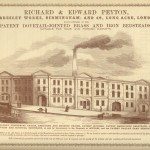Glossary
Image: Introduction to Patent and Harcourt’s Specification, Castors for Furniture. Patent AD1839 No 8240. An example the front page of this patent for brass castors for furniture.
[Image from: Birmingham Central Library, Local Studies and History]
| Brass | An alloy of copper and zinc, usually in the ratio of 60-80% copper and 40-20% zinc. |
| Calamine | Zinc carbonate (ZnCO3), an ore of zinc found in carboniferous limestone regions, such as Derbyshire and Cornwall. |
| Calamine Brass | Produced by smelting calcined calamine with broken or granulated copper, it has a maximum of 28% zinc content. |
| Cementation Process | The heating together of zinc ore and copper to produce brass. |
| Crock-brass | The term used for the copper lead alloy which is used mainly for the casting of domestic pots. |
| Gun-metal | An alloy made up of 80% copper, 9% yellow brass, 10% tin and 1% lead, although the mixture can vary. |
| Latten | An old name for brass encompassing that used for medieval church brasses |
| Paktong | Originating in China, this alloy of zinc, copper and nickel was used as a cheap alternative to silver (which it resembled) in eighteenth century England. |
| Patent | An official document giving inventors the right to an income for a term of years from those who may wish to use their invention. |
| Pot-metal | An alloy of copper and lead |
| Spelter | An old name for zinc |
| Yellow Brass | Old name for foundry brass, often containing up to 3% lead to aid casting and machining. |
Continue browsing this section
 The Brass Industry and Brass Workers in Birmingham
The Brass Industry and Brass Workers in Birmingham
 The Early Brass Trade
The Early Brass Trade
 The Origins of the Brass Industry in the Midlands and Birmingham
The Origins of the Brass Industry in the Midlands and Birmingham
 Innovation in the Midlands Brass Industry
Innovation in the Midlands Brass Industry
 Brassworking Skills in Birmingham
Brassworking Skills in Birmingham
 Demand for Birmingham Brass in Britain and Abroad
Demand for Birmingham Brass in Britain and Abroad
 Entrepreneurship 1: Birmingham Brassfounders and the Building of the Brass House
Entrepreneurship 1: Birmingham Brassfounders and the Building of the Brass House
 Entrepreneurship 2: The Birmingham Metal Company and The Birmingham Mining and Copper Company
Entrepreneurship 2: The Birmingham Metal Company and The Birmingham Mining and Copper Company
 The Organisation of the Birmingham Workforce
The Organisation of the Birmingham Workforce
 Working Practices and Conditions in the Birmingham Brass Industry
Working Practices and Conditions in the Birmingham Brass Industry
 Trades Unions
Trades Unions
 Conclusion: Further Investigation
Conclusion: Further Investigation
 Glossary
Glossary






